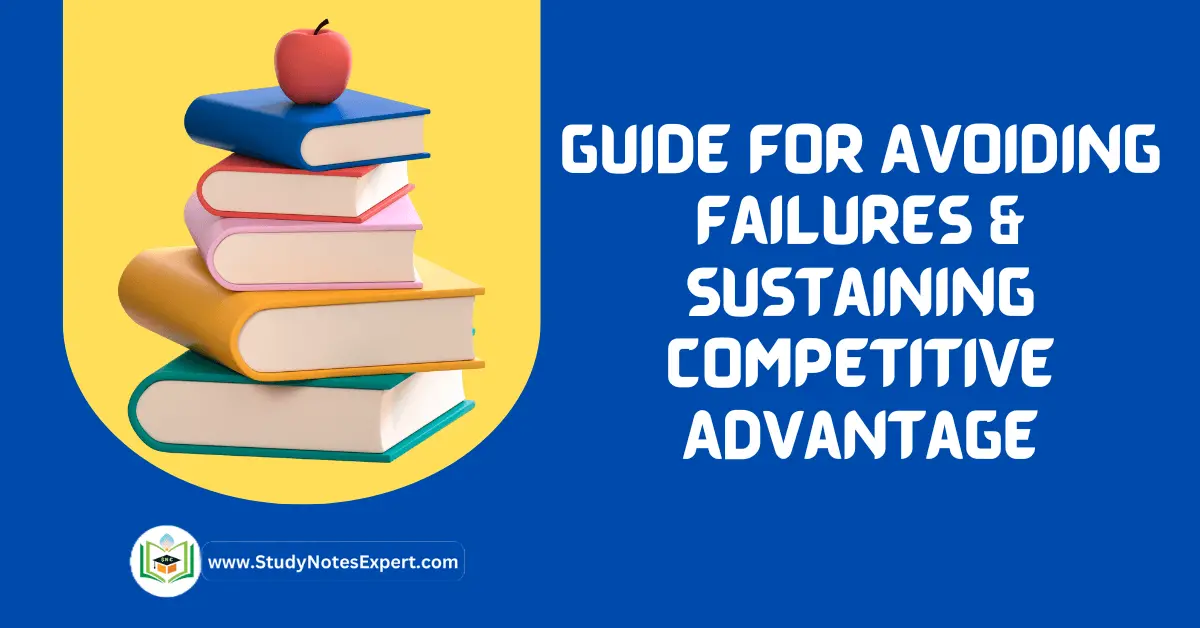Businesses must be proactive, adaptable, and focused on non-stop development to sustain their aggressive advantage. In the following article, you will know about avoiding failures & sustaining competitive advantage. It requires a deep know-how of the marketplace, a consumer-centric technique, and a commitment to staying beforehand of the curve. Keeping an aggressive benefit is important for fulfillment and growth in the ever-evolving international enterprise. Leaders can make failure a competitive advantage for a business man. However, sometimes, agencies may need help to sustain their aggressive part. Let’s explore reasons why companies lose their competitive advantage beforehand.
Avoiding Failures & Sustaining Competitive Advantage
Failing businesses are more than just underneath common: they earn very low or poor profits. Three causes of competitive analysis failure are explored right here:
1) Inertia
The inertia argument is that corporations need help to trade their techniques and structures to adapt to converting competitive situations. It includes:
i) A business enterprise’s talents contribute to inertia because they’re tough to exchange. Changing abilities could require a redistribution of electricity and impact many key decision-makers. Therefore, it may be resisted. Turf battles may also result.
ii) Thus, abilities can offer aggressive benefits and additional competitive disadvantages.
2) Prior Strategic Commitments
Prior strategic commitments, consisting of investments in specialized sources, may also contribute to competitive failure because the resources aren’t nicely-perfect for different, evolving uses of changing resources is difficult and luxurious.
3) Icarus Paradox
The Icarus paradox is based on the Greek fantasy of Icarus, who made himself a pair of wings from wax and feathers, then flew so nicely that he went too near the sun, melting the wings and plunging to his demise. The paradox is that his best asset, his capacity to fly, gave upward thrust to his demise. It consists of:
i) Many hit businesses end up so dazzled by their early achievement that they agree that pursuing the identical course of movement is the manner to destiny achievement. They might also pursue strategies that include “craftsmen,” “builders,” “pioneers,” and “salesmen.”
ii) This mindset leads an employer to become so specialized and inner-directed that it loses sight of market realities and the fundamental necessities for attaining a competitive gain. Sooner or later, failure ensues.
Also, there can be different ways to turn failed experiments into competitive advantage.
Steps to Avoid Failure
To avoid failure, organizations can recognize the building blocks of aggressive advantage, institute continuous improvement and gain knowledge of music, pleasant business exercise, use benchmarking, and overcome inertia. Managers also can learn to take advantage of success. Here, you will know the steps for avoiding failures & sustaining competitive advantage. It consists of:
1) Maintaining an aggressive advantage requires an organization to preserve focus on the four prevalent constructing blocks of aggressive benefit-efficiency, satisfaction, innovation, and consumer responsiveness-and to do something is vital to expand special capabilities that contribute closer to advanced overall performance in these regions. It is the first step for avoiding failures & sustaining competitive advantage.
2) One of the nice ways to develop different skills is to identify and undertake excellent industrial practice. It is the next step for avoiding failures & sustaining competitive advantage. Only through doing so will an agency construct and maintain the resources and capabilities that underpin excellence in productivity, high quality, innovation, and consumer responsiveness.
3) The capacity to overcome the inertial obstacles to trade inside an employer is one of the key necessities for persevering to keep an aggressive advantage. It is the next step for avoiding failures & sustaining competitive advantage.
4) Luck can play an important function in determining competitive achievement and failure, but it is an unconvincing explanation for the continual success of a business enterprise. It is tough to imagine how sustained excellence can be fabricated from something aside from conscious effort, i.e., strategy. However, businesses may be flexible and prepared to exploit fortunate breaks as they arise.

